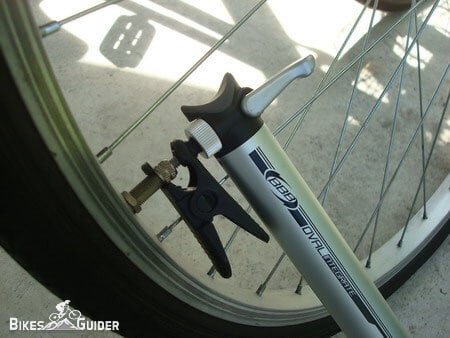How to pump your bike tire
The most inquired question about bikes is how to pump bicycle tire properly. As long as you have a clue as to what tools are needed to inflate bike tires, the task will be significantly simplified. There are numerous dynamic and unique types of tubes and tires, pumps, and even inflators.
This can be a real challenge, especially for beginners and first-timers.
It’s common knowledge that tires cannot function normally without air inside them. They should be pumped and restored to the required psi; this is no easy task if I may add.

If you are wondering what pressure to use to inflate the bike tire, then look on the tire’s sidewall, it’s engraved there. There is the maximum, and minimum pressure indicated. If you want your bike tires to reach a particular hardness, then you have to put a few issues into consideration.
Here is a manual on pumping bicycle tire that you will use to understand all things better tires and inflation. It will help you take the first step towards doing this easy task by yourself and never need to visit the bike shop for this issue again.
Choose the Correct Pump To Inflate Bike Tires
Invest more money into pumps. A cheap pump may give you the wrong psi reading, weaker materials, and very difficult pumping.
A common error that almost every newbie rider does is struggling to use a Schrader pump with a Presta valve. It will never work even if you try a million times.
Two of the most popular tube valves include a Schrader and a Presta valve.
The Presta valve is known for being very narrow and features a locking nut. This can be adjusted to remove or increase the air. The wider valve is the Schrader valve, which is flat at its end. Asking for advice as to which valve to buy from the bike shop is a good idea especially when in doubt.
Steps on How to Pump Bicycle Tire
- The Presta Valve
- A Schrader Valve
- Woods Valves
Method one – The Presta Valve
It is also known as a Sclaverand or better yet, a French valve. It’s narrower and wider. It has an external system of valve that is enclosed in a valve cap. They are mostly found on road bikes. The common valve core does not surround them.

Step One: The valve should be checked and the tire deflated.
Locate the valve, remove the dust cap and place it somewhere secure for easy retrieval.
Step Two: Inspect the valve.
Release some air if the valve has remained without being opened for some time. This also happens to deflate the tire.
Step Three: Presta Valve or Sports Valve
You should unscrew the tiny nut that is used to lock the Presta valve. This should be carried out before the tire is inflated. The air later released.
Step Four: Connect the Pump
When a pump that contains dual openings is being used, the smaller is designed for a Presta valve.
It is recommendable to use a station pump from a local gas station.
The hose or pump connection may be screwed on or pressed on. Some rare push-fit connections may lock with a cam lever. To examine the required operation of the connection, try looking at the rubber washer and moving the lever backward and forwards.
The “locked” position squeezes the washers relax. The rubber washer in a pump connector wears out with use. It needs to be replaced when it stops gripping valves to give an air-tight seal.
Step Five: Presta Valve
If your pump or hose has a push-fit, press the connection on parallel to the Presta valve to avoid releasing air or bending the Presta valve stem.
Put the pump on the valve. If there’s a lever near the nozzle, make sure it’s parallel to the nozzle. When you are putting it on the valve; try to snap the lever down hard perpendicular to the nozzle when it’s on. Keep a close eye on the PSI as you pump.
The lever should be flipped back up to remove the pump, and screw the brass cap closed, then replace the dust cap.
- RELATED: How to Fix Flat Bicycle Tire
Method Two – A Schrader Valve
It’s also known as an American valve, or better yet, a car valve. A threaded valve core entirely circumnavigates the valve stem: to press down the stem, you will have to use a tool like a pen cap or your thumbnail.

- Check the Schrader Valve and deflate the tire. After locating the Schrader Valve, remove the dust cap.
- Check Valve– If the valve has remained unopened for a few days, release a short hiss of air to ascertain that it’s not stuck. Using a similar process, while holding the valve open longer rapidly deflates the tire.
- Schrader Valve or Auto Valve – Press the valve stem down to release air. Try using a blunt tool; it will surely come in handy.
- Connect the Pump
If you’re using a bike pump with dual openings, the larger one is used for the Schrader valve.
Smart pumps have only one opening will automatically adjust accommodating a Schrader valve.
Schrader– When the connector goes either on or off, a small amount of air is released. Aiming parallel to the valve, the connector should be pulled off, to prevent further air loss immediately after pumping.
A locking lever is mandatory for a Schrader valve that has a push-fit connection.
Inflate a tire pumping– The piston should be compressed to the very end to force air inside the tire. The air in the pump may not flow into the tire, and be compressed instead.
To deflate a tire using a Schrader valve, just press the springy valve stem with the use of a fingernail or other tiny tool until the air escapes.
Many modern pumps can be changed between Presta and Schrader fitting, usually by dismantling connection and reversing the direction of parts.
Method Three – Woods Valves.
A woods valve is also known as Dunlop or English valve and commonly used in Asia and Europe. It is larger and resembles a Schrader valve, and uses the same process as a Presta valve.

Tips
- You should fill the tires until firm if and when the pressure is not indicated at the side tire.
- You should snap a picture of your bike if you cannot determine the type of valve it needs when going to purchase the pump
- The air pressure should be checked after a few days to ensure the tires are still properly inflated. If they are not, you will have to replace the inner tubing.
- The valve caps should be taken care of. If lost, the valves can get dry, leading to pumping difficulties.
Warnings
- It is advisable to keep newly inflated tires away from sharp damaging objects.
- The correct volume of air should be pumped into the tires. Too much pumping may lead to bursting of the tires.
Qsn: How can I know whether I have pumped enough air into the tire?
Ans: The tire will feel firm – you should not be able to pinch the sidewalls of the tire together very much. There should not be any loose or empty tire space.
Qsn: What occurs if there is over-pumping of the tires?
Ans: It may result in an explosion inside the tire. A check of the sidewall should be conducted to ensure it has the required pressure it can freely handle.
It will explode inside the tire. The sidewall should be checked to find the minimum and maximum pressure it can handle.
Did you find the desired information you’re looking for the method to pump bicycle tire accurately? Probably YES! If so, then please don’t forget to leave a comment below this article. By this, I get more inspiration to write more articles like this to help cyclist over the world. Happy Pedaling!
Reference: Bicycles Stack Exchange, Anandtech, sancarlosmexico

